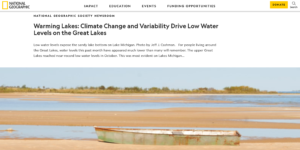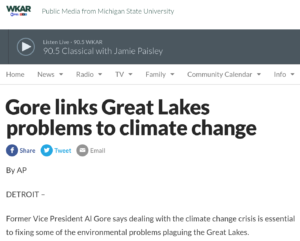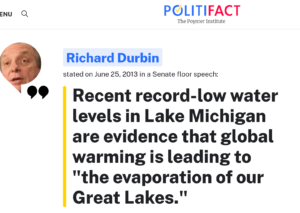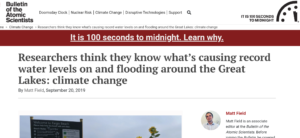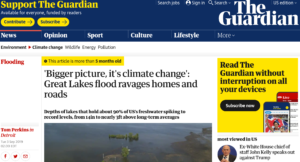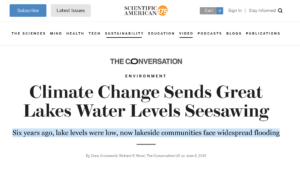Here we go again. Make opposite observations about how ‘climate change’ will do X,Y, or Z and then no matter what happens, you are correct! There is no way to falsify your predictions because you covered all outcomes!
2012: Warming Lakes: Climate Change and Variability Drive Low Water Levels on the Great Lakes
#
#
#
But wait! Just a few years later, ‘global warming is blamed for HIGH water levels.
#
2019: ‘Bigger picture, it’s climate change’: Great Lakes flood ravages homes and roads
#
2019: Climate Change Sends Great Lakes Water Levels Seesawing – Six years ago, lake levels were low, now lakeside communities face widespread flooding – As recently as 2013, water levels on most of the Great Lakes were very low. At that time some experts proposed that climate change, along with other human actions such as channel dredging and water diversions, would cause water levels to continue to decline. This scenario spurred serious concern. Over 30 million people live within the Great Lakes basin, and many depend directly on the lakes for drinking water, industrial use, commercial shipping and recreation. But since 2014 the issue has been too much water, not too little. High water poses just as many challenges for the region, including shoreline erosion, property damage, displacement of families and delays in planting spring crops.
#
‘Global warming’ was blamed for evaporating the Great Lakes, now blamed for high water levels in Chicago’s ‘climate emergency’
“What we are seeing in global warming is the evaporation of our Great Lakes.” That was Illinois Senator Dick Durbin in 2013 when Lake Michigan was at a record low. You can find plenty of claims to the same effect from the time. Nobel Prize winner Al Gore chimed in around then, too, saying climate change was driving Great Lakes levels down by causing evaporation.
by causing evaporation.
But that was then and this is now.
What’s causing today’s record high levels? Climate change, naturally.
So now, citing “catastrophic lakefront erosion” from high water, Chicago just declared a climate emergency. It’s radical, and is reproduced in full below.
Mayor Lori Lightfoot and Durbin want the federal government to help Chicago pay for damage to its shoreline. Lightfoot’s accompanying statement is reproduced below. You’ll be relieved to see that she’s putting “equity” at the center.
Given that Lightfoot hasn’t exactly been friendly to President Trump, you might be concerned about what reception her request for federal help will get. Per the Chicago Tribune, Lightfoot acknowledged “some concern, of course,” that President Donald Trump won’t see the urgency in sending help to Chicago — a city he has treated as a public antagonist for years — to combat climate change, an issue he hasn’t deemed a high priority.
Why, yes, I’d have some concern, too, of course. She called Trump’s visit to Chicago “insulting, ignorant buffoonery.” Not that he’s vindictive or anything.
And since sustainability is emphasized in Lightfoot’s statement, I’d also have some concern about sustainability of claims about the causes of Great Lakes water fluctuations. I confess to being old enough to remember exceptionally high lake levels in the late 1970s when global cooling was blamed. Going back much further, levels were way up where today’s Ridge Road is in the northern suburbs, which created the ridge (but, no, I’m not that old).
Lake Michigan water levels have bounced up and down drastically since at least 1920, and probably throughout history. The chart below is from a Wisconsin environmental and climate group called Southeastern Wisconsin Coastal Resilience.

This article was updated to add the chart above and the climate resolution below.
The climate emergency resolution:
RESOLUTION DECLARING A CLIMATE EMERGENCY AND EMERGENCY MOBILIZATION EFFORT TO RESTORE A SAFE CLIMATE
WHEREAS, in April 2016 world leaders recognized the urgent need to combat climate change by signing the Paris Agreement, agreeing to keep global wamiing, “well below 2°C above pre-industrial levels” and to “pursue efforts to limit the temperature increase to 1.5°C”; and
WHEREAS, the death and destruction already wrought by current average global warming of 1 °C demonstrate that thc Earth is already too hot for safety and justice, as attested by increased and intensifying wildfires;floods,rising seas, diseases, droughts, and extreme weather; and
WHEREAS, according to the United Nations’ Special Rapporteur on Extreme Poverty, 1.5°C of global waming could expose 500 million people to water poverty, 36 million people to food insecurity because of lower crop yields, and 4.5 billion people to heat waves; and
WHEREAS, in October 2018, the United Nations released a special report which projected that limiting warming to even the dangerous 1.5°C target this century will require an unprecedented transformation of every sector of the global economy by 2030: and
WHEREAS, the United States of America has disproportionately contributed to the climate and ecological emergencies and thus bears an extraordinary responsibility to rapidly solve these crises; and
WHEREAS, climate change will continue to make basic human necessities such as food, housing, health care, transportation and energy more expensive and difficult to obtain; and
WHEREAS, in July 2019, members of Congress introduced a concurrent Congressional resolution to declare a national climate emergency in the United States, calling for a “national, social, industrial, and economic mobilization of the resources and labor of the United States at a massive scale to halt, reverse, mitigate, and prepare for the consequences of the climate emergency and to restore the climate for future generations”; and
WHEREAS, restoring a safe and stable climate requires a Climate Mobilization, an emergency mobilization on a scale not seen since World War 11 in order to reach zero greenhouse gas emissions across all sectors ofthe economy; to rapidly and safely drawdown and remove all the excess carbon from the atmosphere at emergency speed and until safe, pre-industrial climate conditions are restored; and to implement measures to protect all people and species from the consequences of abrupt climate breakdown; and
WHEREAS, such necessary measures to restore a safe climate include:
a) A rapid, just, managed divestment and phase-out of fossil fuels; and
b) Ending greenhouse gas emissions as quickly as possible to establish a zero-emissions economy; and
c) A widespread effort to safely drawdown excess carbon from the atmosphere; and
d) A full transition to a regenerative agriculture system; and
c) An end to the Sixth Mass Extinction through widespread conservation and restoration of ecosystems; and
WHEREAS, justice requires that frontline and marginalized communities, which have historically borne the brunt of the extractive fossil-fuel economy, participate actively in the planning and implementation of this mobilization effort and that they benefit first from the transition to a climate-safe economy; and
WHEREAS, the massive scope and scale of action necessary to stabilize the climate and biosphere will require unprecedented levels of public awareness, engagement, and deliberation to develop and implement effective, just, and equitable policies to address the climate emergency; and
WHEREAS, to slay within 1.5 degrees Celsius, niajor cities throughout the world will need to significantly reduce their per capita emissions by 2030, and as a global city, Chicago is obligated to lead by example; and
WHEREAS, lhe 2008 Chicago Climate Action Plan slates that. “Without rapid local and global action, impacts on Chicago’s climate could be adverse,” and thai “[l]he benefits of early action will improve quality of life and preserve Chicago for future generations”; and
WHEREAS, in 2017, the City ofChicago organized global leaders to sign onto the Chicago Climate Charter, with more than 50 cities worldwide, pledging to reduce carbon emissions in line with the Paris Agreement and committed to reaching 100% renewable energy for all electricity used in municipal buildings by 2025; and
WHEREAS, the City of Chicago continues to endure myriad effects of climate change, including bul not limited to catastrophic lakefront erosion, citywide fiooding.and severe unseasonal weather; and
WHEREAS, in 2019. members of City Council have called for the re-establishmenl ofthe Department of Environment to oversee the implemeniation of climatc-relalcd policies and programs: and
WHEREAS, our communities can display their resilience by creating and executing emergency planning that is tailored to address direcily the irue scope of the challenges we face; now, therefore,
BE IT RESOLVED, the City of Chicago hereby declares a state of climate emergency that threatens thc health and well-being of Chicago, its inhabitants, and its environment; and
BE IT FURTHER RESOLVED, City Council will work with the Mayor’s office and city departments to develop a budget that promotes urgent climate action; and
BE IT FURTHER RESOLVED, the City of Chicago calls on the State of lllinois, the United States Congress, the President of the United States, and all govemments and people worldwide to declare a climate emergency, initiate a Climate Mobilization to reverse global warming and the ecological crisis, and provide maximum protection for all people and species of the world; and
BE IT FURTHER RESOLVED, in furtherance of this resolution, the City Clerk shall submit a certified copy of this resolution to elected officials at the federal, state and county levels and request that all relevant support and assistance in effectuating this resolution be provided.
Mayor Lightfoot’s statement:
“Mayor Lightfoot is committed to a proactive environmental agenda that puts equity at its center and prepares Chicago to protect all of its communities, especially those most vulnerable, from pollution and other threats to our shared environment. In order to meet an ambitious climate agenda, the administration is currently in the process of hiring a Chief Sustainability Officer (CSO) who will ensure a dedicated focus on current climate and environmental issues from the Mayor’s Office. The CSO will work alongside the Committee on Environmental Protection and Energy as well as community stakeholders to develop forward-looking policy solutions that focus on equity and which will focus on protecting the environmental health all of our communities for the future.”
#
Dr. Roy Spencer: It is a truism that any observed change in nature will be blamed by some experts on global warming (aka “climate change”, “climate crisis”, “climate emergency”).
When the Great Lakes water levels were unusually low from approximately 2000 through 2012 or so, this was pointed to as evidence that global warming was causing the Great Lakes to dry up.
Take for example this 2012 article from National Geographic, which was accompanied by this startling photo:

The accompanying text called this the “lake bottom”, as if Lake Michigan (which averages 279 feet deep) had somehow dried up.
Then in a matter of two years, low lake levels were replaced with high lake levels. The cause (analysis here) was a combination of unusually high precipitation (contrary to global warming theory) and an unusually cold winter that caused the lakes to mostly freeze over, reducing evaporation.
Now, as of this month (June, 2019), ALL of the Great Lakes have reached record high levels.
Time To Change The Story
So, how shall global warming alarmists explain this observational defiance of their predictions?
Simple! They just invoke “climate weirding”, and claim that the climate emergency has caused water levels to become more erratic, to see-saw, to become more variable!
The trouble is that there is that there is no good evidence in the last 100 years that this is happening. This plot of the four major lake systems (Huron and Michigan are at the same level, connected at the Straits of Mackinac) shows no increased variability since levels have been accurately monitored (data from NOAA Great Lakes Environmental Research Laboratory):


This is just one more example of how unscientific many global warming claims have become. Both weather and climate are nonlinear dynamical systems, capable of producing changes without any ‘forcing’ from increasing CO2 or the Sun. Change is normal.
What is abnormal is blaming every change in nature we don’t like on human activities. That’s what happened in medieval times, when witches were blamed for storms, droughts, etc.
One would hope we progressed beyond that mentality.
#
Related Links:


Morano: We’ve been told climate change leads to less snow AND that it leads to more snow. It causes more hurricanes and fewer hurricanes, longer bird migrations and also shorter bird migrations. Global warming causes more crime, but, get this, reducing crime causes more global warming. And if you disagree with any part of this of scenario…you might just be a “climate denier”— and belong in jail yourself!
Today…A sort of “climate astrology” has taken over. Many climate claims have descended into the realm of the predictions of Nostradamus or the Mayan calendar. There is no way anyone can falsify the global warming theory now because any weather event that happens “proves” their case.
Stop the confusion! Global warming will cause less hurricanes or more hurricanes or more powerful but less frequent hurricanes or have no known impact on hurricanes and will cause less rain or more rain. In other words, predict every possible outcome and you too can claim you predicted it! No matter what happens with hurricanes, the climate establishment can confidently claim, they were right.
Watch Now: Clip from ‘Climate Hustle’ explains how all things are caused by ‘global warming’
‘Earth’s rotation to slow down…Earth’s rotation to speed up…Great Lakes less snow…Great Lakes more snow…Malaria may increase…Malaria may continue decreasing…San Francisco less foggy…San Francisco more foggy…Winters maybe warmer…Winters maybe colder’
Related Links:

Flashback 2007: ‘Global warming’ will ‘reduce the length of a day’ – ‘Make Earth spin faster’

(More: via the Corbett Report)
Climate change makes for shorter winters
Climate change makes for harsher winters
Climate change means less snow

Climate change means more snow
Climate change causes droughts in California
Climate change causes floods in Texas and Oklahoma
Climate change makes wet places wetter and dry places drier…

…except when it makes wet places dryer…

…and dry places wetter

Climate change causes more hurricanes
Climate change causes less hurricanes
Climate change causes more rain (but less water)
Climate change causes less rain
Climate change decreases the spread of malaria
Climate change increases the spread of malaria
Climate change makes San Francisco foggier
Climate change makes San Francisco less foggy
Climate change causes duller autumn leaves
Climate changes causes more colourful autumn leaves
Climate change makes for less salty seas
Climate change makes for saltier seas
Climate change causes Antarctica to lose land ice

Climate change causes Antarctica to gain land ice
Climate change makes the earth hotter…

…unless the earth isn’t getting hotter…

…in which case climate change can explain that, too.


